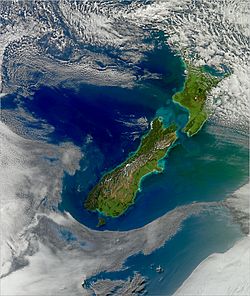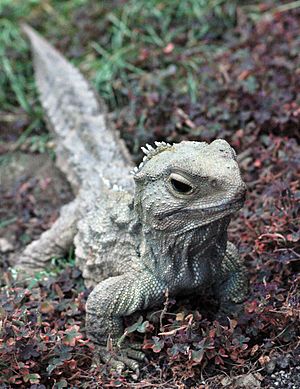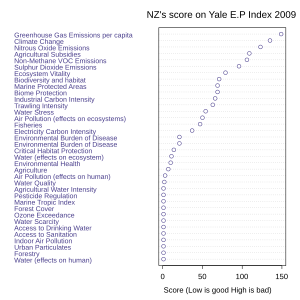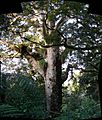Environment of New Zealand facts for kids
The environment of New Zealand is characterised by an endemic flora and fauna which has evolved in near isolation from the rest of the world. The main islands of New Zealand span two biomes, temperate and subtropical ,complicated by large mountainous areas above the tree line. There are also numerous smaller islands which extend into the subantarctic. The prevailing weather systems bring significantly more rain to the west of the country. New Zealand's territorial waters cover a much larger area than its landmass and extend over the continental shelf and abyssal plateau in the South Pacific Ocean, Tasman Sea and Southern ocean.
Historically having an isolated and endemic ecosystem far into modernity, the arrival of Polynesians about 1300 AD and then later European settlers began to have significant impacts on this system, with the intentional and unintentional introduction of new species and plants which often overwhelmed their natural competitors, leading to a significant loss of native ecology and biodiversity, especially in areas such as bird life.
Today, most parts of New Zealand are heavily modified by the effects of logging, agriculture and general human settlement, though large areas have also been placed under protection, combined in many cases with efforts to protect or regenerate native ecosystems (aided by the fact that especially the South Island of New Zealand has a very low population density).
Contents
Biota
The biota of New Zealand is one of the most unusual on Earth, due to its long isolation from other continental landmasses. Its affinities are derived in part from Gondwana, from which it separated 82 million years ago, some modest affinities with New Caledonia and Lord Howe Island, both of which are part of the same continental plate as New Zealand and in part from Australia.
More recently a component has been introduced by humans. New Zealand's biodiversity exhibits high levels of endemism, both in its flora and fauna. Until recently the islands had no native terrestrial mammals except for bats (although terrestrial, "archaic" mammals did exist in New Zealand until 19 million years ago, in the form of the Saint Bathans mammal), the main component of the fauna being insects and birds. Its flora is dominated by Gondwanan plants, comprising historically of forests, most famously the giant kauri. New Zealand has developed a national Biodiversity Action Plan to address conservation of considerable numbers of threatened flora and fauna within New Zealand.
Fauna
Birds
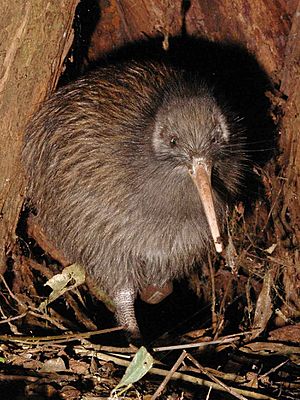
Conservationists recognised that threatened bird populations could be saved on offshore islands, where, once predators were exterminated, bird life flourished again. Around 30 species are listed as endangered. The kiwi, a national symbol, is also under threat. A curious bird, it cannot fly, has loose, hair-like feathers and long whiskers, and is largely nocturnal.
Mammals
The only terrestrial mammals that were in New Zealand prior to human habitation were three species of bat. A number of marine mammals are found on the coast and waters of New Zealand. Maori and European settlers introduced a wide range of mammals some of which have become serious invasive species.
Flora
New Zealand has a richly varied flora of imported and native species, the indigenous varieties having developed quite significantly due to the geographic isolation of the country before human migration and plant imports became common. However, the combination of external factors such as climate change and invasive species, as well as increasing agricultural and other human land uses have led to widespread damage. New Zealand's forest ecosystems for example are being considered as the second most endangered of the world, with only 7% of the natural habitat remaining.
Climate
The climate varies from cool temperate in the south and warm temperate in the north, with the exception of the North Island Volcanic Plateau. Rainfall varies from a low of 325 mm in Central Otago to an average of 5-8,000 mm in Fiordland. Most lowland areas have ample rainfall for farming and habitation. In the South Island, the high Southern Alps, which run north–south, cause a marked difference between the west and east coast climates.
Geography
For a small country the geography is extremely varied in both landforms and altitude. New Zealand's landscape ranges from the fjord-like sounds of the southwest to the tropical beaches of the far north. South Island is dominated by the Southern Alps, the highest peak of which is Aoraki/Mount Cook, at 3,724 metres (12,218 ft). The tallest peak on North Island is Mount Ruapehu (2,797 m), an active, cone-shaped volcano.
Smaller islands include Stewart Island, which lies south of South Island; Waiheke and Great Barrier islands, near the north end of North Island; and the Chatham Islands, more than 800 km east of South Island.
Protected areas
Nearly 30 percent of the land mass of New Zealand is in public ownership and has some degree of protection. The level of protection varies according to the land status.
Evaluations of New Zealand's environmental performance
State of the Environment reporting
The Ministry for the Environment has produced two State of the Environment reports to date, one in 1997 and the other in 2007.
OECD environmental performance review
In 2007, the Organisation for Economic Co-operation and Development (OECD) conducted an environmental performance review of New Zealand. Some of the main conclusions and recommendations were that:
- energy intensity is about equal to the OECD average
- intensity of water, fertiliser, and pesticide use is low for OECD countries. However, the review period saw 'significant increases, with consequent growth in pressures on the environment'
- New Zealand should strengthen national policy guidance (policy statements, national environmental standards)
- New Zealand should further integrate environmental concerns into economic and sectoral decisions, particularly by using economic instruments to internalise environmental costs of economic activities
- New Zealand should further develop international environmental cooperation.
Environmental Performance Index
The Environmental Performance Index (EPI) is a method of quantifying and numerically benchmarking the environmental performance of a country's policies. It results in a score out of 100. In 2016 New Zealand scored 88 out of 100, and ranked 11 out of 132 countries. In 2010, in terms of ecosystem effects on water quality New Zealand scored 40.3 points out of 100 for ecosystem vitality for freshwater and was ranked 43rd out of 132 countries.
| year | rank/total | EPI |
|---|---|---|
| 2006 | 1/133 | 88.0 |
| 2008 | 7/149 | 88.9 |
| 2010 | 15/163 | 73.4 |
| 2012 | 14/132 | 66.1 |
| 2014 | 16/178 | 76.4 |
| 2016 | 11/132 | 88.0 |
Environment and politics
The Values Party, the first ever national level environmental party, was formed in 1973. The Green Party of Aotearoa New Zealand, which was formed in 1991 and included some members from the defunct Values Party, was initially in Parliament as part of the Alliance Party. They currently have nine MPs that put forward green political ideology.
The level of protection of the environment from the different political parties varies according to their position on the left-right political spectrum. The right wing ACT Party scores the lowest and the left wing Green Party scores the highest.
| Party | 2002 | 2005 | 2008 |
|---|---|---|---|
| Alliance | 56% | ||
| ACT Party | 10% | 10% | |
| Green Party | 97% | 97% | 97% |
| Labour Party | 57% | 61% | 44% |
| Maori Party | 83% | 87% | |
| National Party | 27% | 43% | 27% |
| NZ First | 59% | 50% | 78% |
| Progressive Party | 76% | 81% | 60% |
| United Future | 28% | 48% | 53% |
Environmental law
The roots of New Zealand environmental law can be traced to the common law of Britain. The increasing environmental awareness of the 1960s led to a specific body of environmental law that developed in many Western countries including New Zealand. Environmental law became more integrated in the 1980s with the passing of the Environment Act 1986 and the Conservation Act 1987. These Acts set up the Ministry for the Environment, Parliamentary Commissioner for the Environment and the New Zealand Department of Conservation.
The most significant Act of Parliament concerning environmental law was the passing of Resource Management Act in 1991. Issues under the Act are adjudicated by the Environment Court of New Zealand.
Treaties and international agreements
New Zealand is a signatory to a number of treaties and international agreements:
- The Framework Convention on Climate Change, 1992 – ratified on 8 September 1993
- The Convention on Biological Diversity, 1992 – ratified on 16 September 1993
- The Montreal Protocol on Substances that Deplete the Ozone Layer, 1989 – ratified on 21 July 1988
- The Antarctic Treaty, 1959 – ratified on 1 November 1960 – Convention for the Conservation of Antarctic Marine Living Resources, 1980 – ratified on 8 March 1982 – and others
- United Nations Convention on the Law of the Sea, 1982 – ratified on 19 July 1996
- The Basel Convention on the Control of Transboundary Movements of Hazardous Wastes and their Disposal, 1989 – ratified on 20 December 1994
- The Stockholm Convention on Persistent Organic Pollutants 2001 – ratified on 24 September 2004.
- Convention on the Prevention of Marine Pollution by Dumping of Wastes and Other Matter, 1971 (London [Dumping] Convention) – ratified on 30 April 1975 – and the International Convention for the Prevention of Pollution from Ships, 1973 – not yet ratified
- The Convention on International Trade in Endangered Species of Wild Flora and Fauna, 1973 – acceded to on 10 May 1989
- The Convention on Wetlands of International Importance especially as Waterfowl Habitat, 1971 (Ramsar Convention) – signed on 13 August 1976 with effect from 13 December 1976
- Convention for the Prohibition of Fishing with Long Driftnets in the South Pacific, 1989 (Wellington Convention) – ratified on 17 May 1991
- South Pacific Nuclear Free Zone Treaty, 1985 – ratified on 13 November 1986
- Convention for the Protection of the Natural Resources and Environment of the South Pacific Region, 1986 [SPREP] – ratified on 3 May 1990
- The Cartagena Protocol on Biosafety to the Convention on Biological Diversity – ratified on 24 February 2005
New Zealand is a depositary to the following environmental treaties:
- Convention on the Regulation of Antarctic Mineral Resource Activities
- Convention for the Conservation and Management of Highly Migratory Fish Stocks in the Western and Central Pacific Ocean (WCPFC)
- Convention for the Prohibition of Fishing with Long Driftnets in the South Pacific
- Protocol I to the Convention for the Prohibition of Fishing with Long Driftnets in the South Pacific
- Protocol II to the Convention for the Prohibition of Fishing with Long Driftnets in the South Pacific
Environmental funding
There are a number of different sources for environmental funding in New Zealand.
The Nature Heritage Fund is a New Zealand Government funding body set up in 1990, and administered by the Department of Conservation, for the purchase of land which has significant ecological or landscape features.
To support community efforts, the Community Conservation Fund is available. Funding is for established community groups that have an ecological restoration project on public land that can be sustained after the two year funding period.
There are also Biodiversity Funds.
Images for kids
-
The effect of bedrock on soil and ecology. Ultramafic rock (left) and mafic rock (right).
-
Large blooms of phytoplankton
-
Water pollution due to dairy farming in the Wairarapa
-
Common brushtail possums, an invasive pest in New Zealand whose population is controlled with 1080


